SHORT URL: http://tinyurl.com/Steele-Hack
PPT (24 Slides with Notes): The Ultimate Hack 1.1
All graphics with full text below the fold.
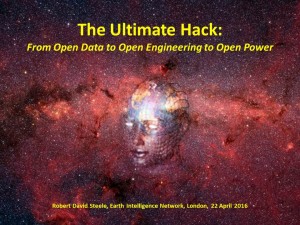
It’s an honor to be here with all of you, I regard you as the single most intelligent and therefore the single toughest and most productive audience for my ideas.
My intent is to place your world-charging efforts with respect to Open Data in a larger context, what I have been calling Open Source Everything Engineering, and to relate that to where I hope we end up one day, with Open Power.
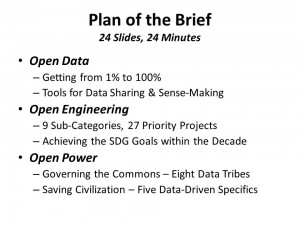
Here is the plan of the brief, 24 slides in 24 minutes, followed by whatever you wish in the way of questions and interaction.
I two sub-topics and six slides for each of these three broad areas where we might reflect together on the possibilities.
PAUSE
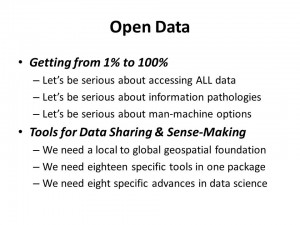
With respect to Open Data, where you are arguably the foremost proponents in the world, I want to sound the alarm, as a professional intelligence officer, with respect to just how impoverished we are in relation to both the data we can access, and the lack of tools for exploiting that data.
I acknowledge all of you as “ground zero.” My hope is to provoke you with a larger vision helpful to your onward progress.
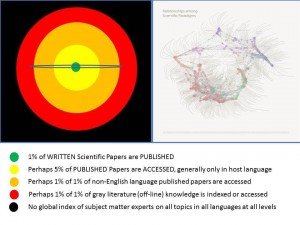
I am troubled by how few – particularly in the governance class – understand that we are processing less than 1% of our Big Data, and that data in turn comprises roughly 1% of what is written which is in turn 1% of what is known.
We don’t need to quibble over the numbers, Mary Meeker and others are on record, let’s just accept that we have, at best, put our toe in the data pool.
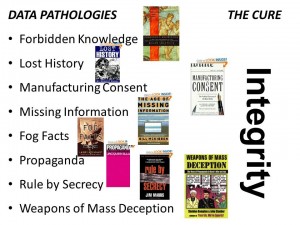
We are also dealing with enormous data and information pathologies.
Each of those shown here is the title of an entire book.
So to sum up, we are only now accessing 1% at best of what could be known – actually closer to 1% of 1% — and we have totally corrupted the manner in which we do that little bit.
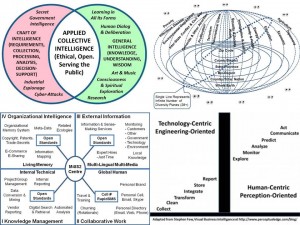
Forgive this complex depiction, it can be studied later if desired, upon concluding I provide a tiny url for accessing this briefing and supporting materials.
Suffice to say that we are decades from achieving the processing and power efficiencies of the human brain. I believe we can and must do a great deal more to harness distributed human intelligence using open source networks and tools.
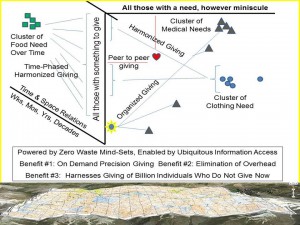
To augment human intelligence and human engagement we need a massive sparse matrix on top of a local to global geospatial foundation, such that we can plot all needs in time and space, and then enable a diversity of humans to “jack in” with human-central time and materials.
This technical needs is also required to plot true costs of every product, service, policy, and behavior.

These eighteen tools do not exist today in one integrated package, neither proprietary nor open source. They were identified as needed in 1986.
We cannot expect industrial-era IT companies to abandon their legacy mind-sets, markets, and controls. If Open Data is to be fully exploited, we need to develop this open source tool-kit at the same time and it must be free to the five billion poor.
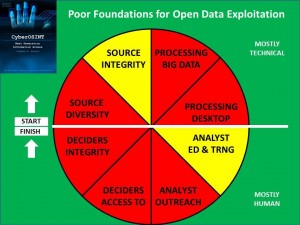
I am perhaps the harshest published critic of both the secret intelligence world and the not-so-secret but equally handicapped IT world. I was among the first to sound the alarm on cyber-vulnerabilities in 1992-1994, and among the first to lament both our data gaps in relation to the third world, and our lack of tools. Across these eight functional areas, half mostly technical and half mostly human, we have failed to be serious. My Foreword to the book on CyberOSINT expands on these concerns.
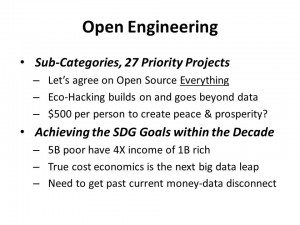
In this next segment, I try to suggest that Open Data is not enough – we must achieve Open Source Everything Engineering – OSEE – across nine major sub-categories with a preliminary focus on 27 priority projects.
If we do this, we an achieve the Sustainable Development Goals (SDG) within the decade. To do that we must focus on the 5B poor, on true cost economics, and on by-passing the current money-data disconnect.

I began listing the opens over a decade ago. In 2007 I made this the focus on my Gnomedex keynote, and in 2011 wrote the book, The Open Source Everything Manifesto.
Open Data is the first major category but notice how each of the other eight categories goes well beyond Open Data.
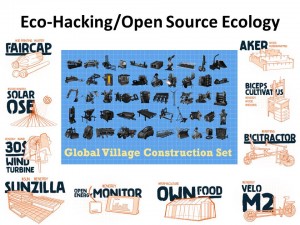
Where might we go? I like the term eco-hacking. Here I show a number of projects from a recent competition, around the larger Global Village Construction Set being created by Marcin Jacubowski.
If Open Data is to have the greatest effect, it must enable the rapid delivery of this kind of affordable, inter-operable scalable knowledge to the five billion poor, by-passing the industrial-era structures.
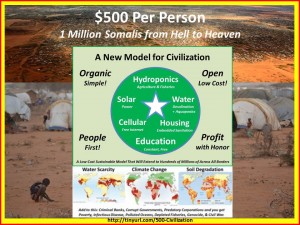
My ideas were put to the test in 2013, when I was challenged to calculate the cost for moving one million Somalis from UN camps in Ethiopia, Uganda, and elsewhere, to an uncontested northeast portion of Somalia with three things in abundance: dirt, seawater, and sunlight.
I did so. The cost per person inclusive of everything needed to live and thrive, came to $500 each. The calculations are at the tiny URL shown in the lower margin.

I am very sorry to note the passing of C.K. Prahalad, he and his collaborators rendered a great service in pointing out that the five billion poor have four times the aggregate income of the one billion rich – they simply buy different things at much lower prices — $2 ceramic coolers buried in the ground, instead of sub-zero fridges costing thousands. This graphic emphasizes the green at the bottom. This is where open source engineering must focus.
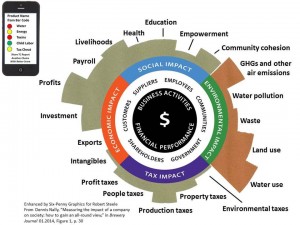
Concurrent with our emphasis on open source everything engineering (OSEE), we must accelerate the abandonment of the old paradigm by documenting and disseminating Open Data about true cost economics.
This will be helpful in also showing the superior sustainable profitability of open source models where many are challenged to demonstrate the financial case.
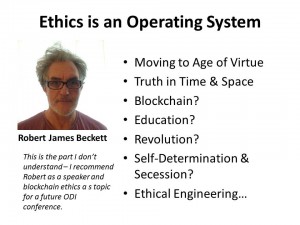
I point to Richard James Becket, himself resident here in London, because he has worked on this topic for years. Although I coined the phrase, “Ethics is an operating system” I have not –and am incapable of – being useful at the intersection of ethics and code. Others will have to make the advances here, but I do want to isolate this as the soul of the new open source world that ultimately re-empowers the 99%.
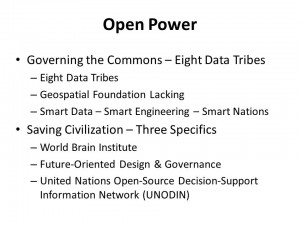
For those who might wish to think that Open Data is a blessed task, one directly related to Saving Civilization, I conclude with this third section, where I hope my ideas might provide a context toward which Open Data might aspire.
There are some challenges I have encountered in the past 25 years, and some specifics I hope you will begin to champion in your own way.
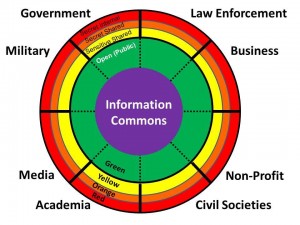
The greatest insight I have achieved in 25 years of wandering in the data wilderness is this: there are eight tribes of information, with iron curtains between the tribes, wooden walls between organizations within the tribes, and plastic curtains between individuals.
We simply do not share. We are selfish and oblivious. A massive cultural as well as technical shift is required.
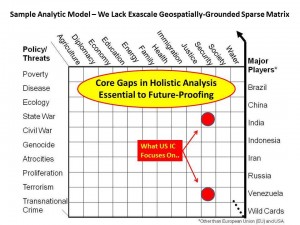
Another insight, partly from being my past as an intelligence professional, and partly from the great joy I have found in reading and reviewing over 2,000 non-fiction books across 98 categories, is that we simply do not think holistically. Neither governments nor corporations nor non-profits have holistic analytic models that help them consider all threats in relation to the true costs of all policies, as well as the collaborative possibilities of working with others.

In 2006 I funded the foundation of the Earth Intelligence Network, and am happiest to have been able to include Medard Gabel, co-creator with Buckminster Fuller of the analog World Game. Medard drafted the architecture, staffing, and budget for the digital Earth Game, which I consider central to making the most of Open Data. We must be able to plot all data in all languages and all mediums on a global grid, and we must be able to play the Global Game at all times.
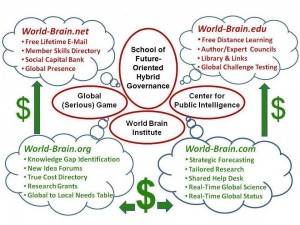
Here is a construct – what I would like to see built, and frankly, how I would like to spend the rest of my life.
We desperately need, in addition to the Global (Serious) Game, a School of Future-Oriented Hybrid Governance that creates educated leadership cadres across the eight tribes. A World Brain Institute can do for knowledge what Vint Cerf and Tim Berners-Lee have done for the Internet.
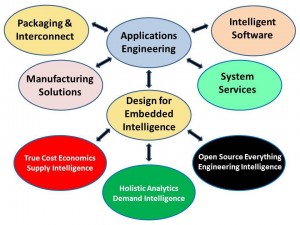
With this next to last slide I want to comment on the flawed approach to Smart Cities being led by the conventional IT industry and embraced by London and in India.
It is not enough to focus on the T in the IT. Peter Drucker said this, I have said it. Here I illuminate how to create a truly Smart City, one that eradicates the 50% waste inherent in industrial-era processes.
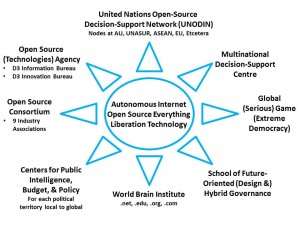
These are the pieces as I envision them. The heart of the matter is the Open Source (Technologies) Agency as I have proposed to Vice President Biden with the signal advantage of having twice obtained approval in principle from the Office of Management at Budget. At $2B a year, that would fund everything else while attracting matching funds – this would make possible the achievement of the SDG goals at a fraction of the cost and in a fraction of the time now envisioned under old mind-sets.
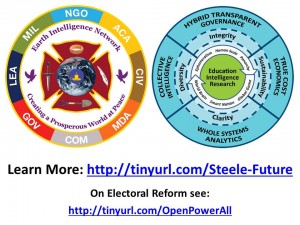
I chose not to address electoral reform and the twelve points today since we are focused on data and code, but I care about that and provide a second tiny url here.
I certainly pray for your own success in the next quarter century, and dare to hope that we might cross paths again in the future.
Thank you.
See Also:
Robert Steele Bio and Publications Online



